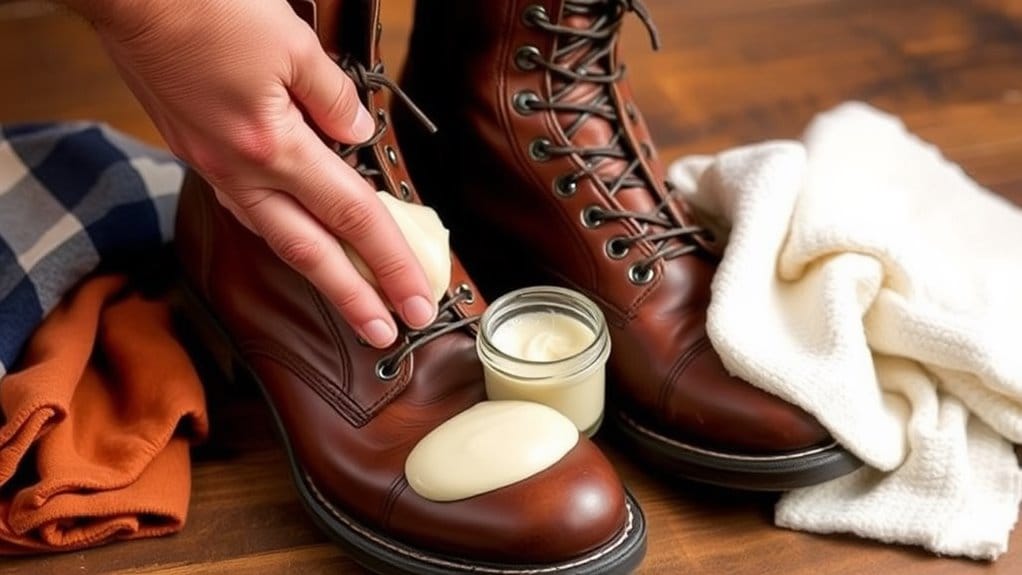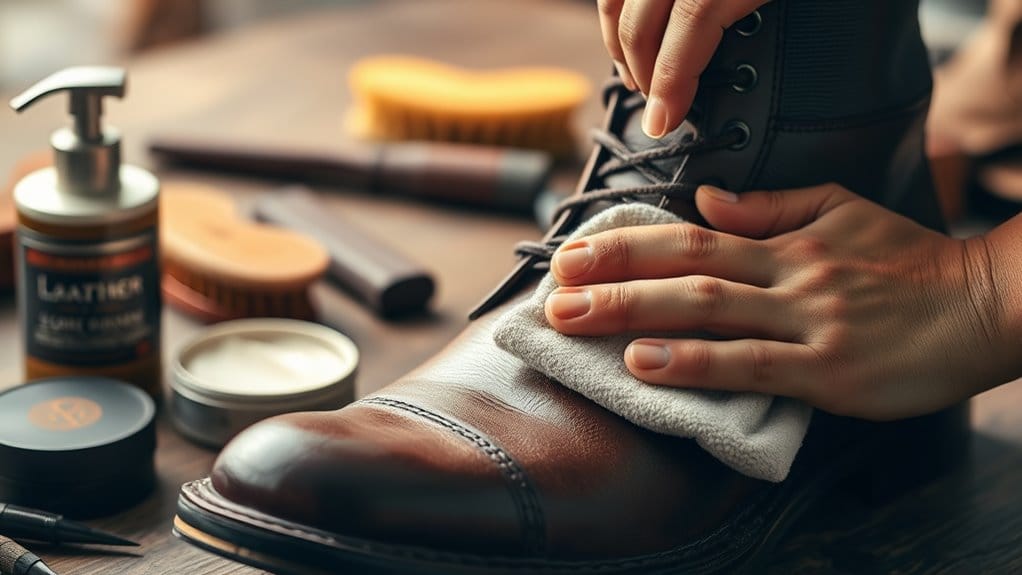This post contains affiliate links. As an Amazon Associate, we earn from qualifying purchases.
To soften leather boots, start by cleaning them with a leather cleaner. Then, use a high-quality leather conditioner applied with a soft cloth in circular motions. Consider using a hairdryer on low heat to enhance absorption, focusing on uncomfortable areas for a minute or two. Another method is a mix of alcohol and water applied gently. If you’re unsure, you might want to seek professional help for expert results. There’s more to learn on making your boots even more comfortable!
Key Takeaways
- Clean the boots with a leather cleaner before applying conditioner to ensure effective absorption and prevent dirt buildup.
- Use a high-quality leather conditioner, applying it with a soft cloth in circular motions for even coverage.
- Apply mild heat using a blow dryer on low, focusing on discomfort areas for 1-2 minutes to enhance flexibility.
- Wear the boots after conditioning and heating to help mold them to your foot shape for improved comfort.
- Consider professional softening services for expert care, especially for high-quality or delicate leather boots, to avoid damage.
Understanding Leather Types and Their Properties
When you’re looking to soften leather boots, it’s essential to understand the different types of leather and their unique properties.
Full-grain leather is the most durable option, retaining its natural texture, making it ideal for high-quality boots.
Top-grain leather offers a smoother finish, as it’s sanded for imperfections, resulting in slightly more pliability.
Genuine leather is a broader term that may include varying qualities, often leading to mixed stiffness and durability.
Bonded leather, made from scraps, is the least durable and usually found in budget products.
On the other hand, suede, derived from the underside of hides, is naturally soft and pliable, perfect for those prioritizing comfort.
Always consider these leather types when choosing your boots.
Tools and Materials for Softening Leather
To soften leather boots effectively, you’ll need the right tools and materials at your disposal.
Start with a soft cloth for applying leather conditioner and a leather cleaner for initial cleaning. A quality leather conditioner or cream will moisturize and soften the leather fibers.
Consider using a mild heat source, like a hairdryer on low, to enhance absorption, making your leather more pliable. For tough leather, mink oil or a specialized softening agent can deeply condition and weatherproof your boots.
Don’t forget cedar shoe trees; they help maintain shape, absorb moisture, and contribute to longevity.
Conditioning the Leather

Conditioning the leather is an essential step in softening your boots, as it helps moisturize and rejuvenate the fibers.
Use a high-quality leather conditioner or cream to effectively soften and enhance flexibility. Apply a small amount of conditioner with a soft cloth, using circular motions to guarantee even distribution and deep penetration into the leather fibers.
Allow the conditioner to sit for the recommended time to achieve ideal absorption and effectiveness. Regular conditioning every few months is important to maintain leather softness and prevent stiffness or cracking over time.
Just be cautious not to over-condition; using too much can lead to a floppy texture, compromising your boots’ support and structure.
Applying Heat
When it comes to applying heat to your leather boots, using the right techniques and tools is essential for safe softening.
You’ll want to monitor the temperature carefully to avoid damaging the leather while ensuring it becomes more pliable.
With the proper approach, you can effectively mold your boots to fit your feet perfectly.
Safe Heat Application Techniques
Applying heat to soften leather boots can be effective if done carefully. Here are some safe heat application techniques to follow:
- Use a blow dryer set to low heat, keeping it about 5 inches away.
- Focus on specific areas of discomfort with localized heating for 1-2 minutes.
- Always monitor temperature; if it’s too hot to touch, let it cool before further heat.
- Wear the boots right after heating to help them mold to your feet for a better fit.
These methods help relax leather fibers, ensuring you prevent overheating while softening leather for maximum comfort.
Tools for Heating Leather
To effectively soften leather boots, you’ll want the right tools at your disposal. A blow dryer is a great option; hold it about 5 inches away from the leather, focusing on problem areas for 1-2 minutes to soften the leather effectively.
If you prefer a heat gun, make sure you use careful handling and set it to low heat to avoid excessive temperatures that can damage your boots.
Alternatively, soaking your boots in lukewarm water for 15-20 minutes can also soften the material.
After you apply heat, wear the boots right away to mold the leather to your foot shape, ensuring a customized fit that feels comfortable and secure.
Monitoring Leather Temperature Carefully
Heating leather is a delicate process that requires careful attention to temperature. Monitoring temperature is essential to prevent overheating and guarantee your leather boots soften properly.
Follow these tips for effective heat application:
- Use a blow dryer about 5 inches away from the leather.
- Focus on areas that cause discomfort for 1-2 minutes.
- Confirm the leather is warm, but not too hot to touch.
- Wear the boots immediately after heating to mold them to your foot shape.
Localized heat helps soften leather, aiding in the stretching process.
However, excessive heat can damage the leather structure, leading to stiffness or shrinking. Keep an eye on the temperature to achieve the best results without compromising your boots.
Using Alcohol and Water Techniques
One effective method for softening leather boots involves using a simple mixture of isopropyl alcohol and water.
Combine equal parts in a spray bottle for easy application. Lightly spray the solution on tight spots that need softening, allowing it to sit for a few minutes to penetrate the leather.
After applying, wear the boots for a few hours; this helps mold the leather to your feet’s shape. Remember to test the alcohol and water mixture on a small area first to verify it doesn’t damage or discolor the leather.
Once you’re done, use a clean cloth to wipe off any excess alcohol solution, preventing the leather from drying out. This technique can effectively soften leather boots.
Trusting a Professional for Softening

When it comes to softening your leather boots, trusting a professional can make a significant difference.
They’ve the right tools and expertise to guarantee your boots are treated properly, preserving their quality and comfort.
Plus, considering the value they provide, it’s worth weighing the cost against the peace of mind and results you’ll get.
Benefits of Professional Services
Trusting a professional to soften your leather boots can make a significant difference in both the results and the longevity of the footwear.
Here are some benefits of opting for expert services:
- Specialized techniques that effectively soften leather
- Tailored conditioning treatments for enhanced comfort
- Access to advanced tools like steamers and custom stretchers
- Peace of mind against damaging your boots
With professional services, you’ll benefit from a deep understanding of leather care that helps restore suppleness and prevents future stiffness.
Experts can assess your specific leather type, applying the right methods for superior results. This not only saves you time but guarantees a perfect fit, enhancing both comfort and longevity.
Letting professionals handle the softening process allows you to enjoy your boots worry-free.
Choosing the Right Expert
Finding the right expert to soften your leather boots can make all the difference in comfort and longevity. Consulting a professional cobbler guarantees they apply the correct softening techniques without risking damage to your leather.
These experts can assess the leather type and condition, determining the best conditioning products tailored to your boots, whether they’re full-grain or suede. Many shoe repair shops specialize in stretching and softening leather, allowing for targeted adjustments in those troublesome areas.
Cost Considerations and Value
Choosing a professional to soften your leather boots brings not just expertise but also a range of cost considerations worth examining. Here are some key points to keep in mind:
- Cost Range: Hiring a professional typically costs between $20 and $100.
- Specialized Techniques: Professionals use high-quality conditioners and steam, yielding superior results compared to DIY methods.
- Longevity Assurance: Trusting a professional minimizes the risk of over-stretching or damaging your boots, ensuring their longevity.
- Warranties and Guarantees: Many shops offer warranties on their work, adding value to your investment.
Investing in professional softening services can extend the lifespan of your high-quality leather boots, ultimately saving you money in the long run.
Conclusion
In summary, softening your leather boots doesn’t have to be an intimidating task. By understanding the type of leather you’re working with and using the right tools and techniques—like conditioning, gentle heat, or alcohol and water—you can make your boots more comfortable. If you’re ever unsure, don’t hesitate to trust a professional. With a little effort, you’ll enjoy a more pliable fit that makes wearing your boots a pleasure. Happy softening!


